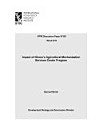Protected agriculture, precision agriculture, and vertical farming: Brief reviews of issues in the literature focusing on the developing region in Asia
Takeshima, Hiroyuki · Joshi, Pramod Kumar
2019年3月 · IFPRI Discussion Paper 第 1814 本图书 · Intl Food Policy Res Inst
3.0star
2条评价report
电子书
49
页
family_home
符合条件
info
report评分和评价未经验证 了解详情
关于此电子书
The frontiers of technologies have been constantly expanded in many industries around the world, including the agricultural sector. Among many “frontier technologies” in agriculture, are protected agriculture, precision agriculture, and vertical farming, all of which depart substantially from many conventional agricultural production methods. It is not yet clear how these technologies can become adoptable in developing countries, including, for example, South Asian countries like India. This paper briefly reviews the issues associated withthese three types of frontier technologies. We do so by systematically checkingthe academic articleslisted in Google Scholar, which primarily focus on these technologies in developing countries in Asia. Where appropriate, a few widely-cited overview articles for each technology were also reviewed. The findings generally reveal where performances of these technologiescan be raised potentially, based on the general trends in the literature. Where evidence is rich, some generalizable economic insights about these technologies are provided. For protected agriculture, recent research has focusedsignificantly on various features of protective structures (tunnel heights, covering materials, shading structures, frames and sizes) indicating that there are potentials for adaptive research on such structures to raise the productivity of protected agriculture. The research on protected agriculture also focuses on types of climate parameters controlled, andenergy structures, among others. For precision agriculture, recent research has focused on the spatial variability of production environments, development of efficient and suitable data management systems, efficiency of various types of image analyses and optical sensing, efficiency of sensors and related technologies, designs of precision agriculture equipment, optimal inputs and service uses, and their spatial allocations, potentials of unmanned aerial vehicles (UAVs) and nano-technologies. For vertical farming, research has often highlighted the variations in technologies based on out-door / indoor systems, ways to improve plants’ access to light (natural or artificial), growing medium and nutrient / water supply, advanced features like electricity generation and integration of production space into an office / residential space, and water treatment. For India, issues listed above may be some of the key areas that the country can draw on from other more advanced countries in Asia, or can focus in its adaptive research to improve the relevance and applicability of these technologies to the country.
评分和评价
3.0
2条评价
作者简介
为此电子书评分
欢迎向我们提供反馈意见。
如何阅读
智能手机和平板电脑
笔记本电脑和台式机
您可以使用计算机的网络浏览器聆听您在 Google Play 购买的有声读物。
电子阅读器和其他设备
如果要在 Kobo 电子阅读器等电子墨水屏设备上阅读,您需要下载一个文件,并将其传输到相应设备上。若要将文件传输到受支持的电子阅读器上,请按帮助中心内的详细说明操作。










